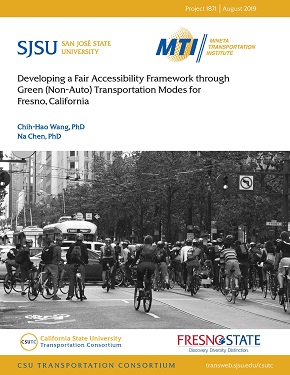- 408-924-7560
- mineta-institute@sjsu.edu
- Donate
Developing a Fair Accessibility Framework through Green (Non-Auto) Transportation Modes for Fresno, California
Fresno, California has been regarded as a city with a high concentration of poverty. Therefore, it is extremely important to examine whether transportation inequality exists in this city because transportation shapes residents’ economic opportunities, physical activities, and social interactions. This study is to address this issue by looking at whether a resident of Fresno would have an equal opportunity to access a variety of urban opportunities, such as jobs, physical activities and dining, social interactions, and public facilities. Two non-auto (green) transportation modes (i.e. transit and cycling) were considered in this study since not everyone can afford for a private vehicle. GIS (Geographic Information System) was first used to illustrate the service area by using these two green transportation modes for each block group in the city. With the recently completed “open street” data, we then used the service area to count the number of various urban opportunities (jobs, restaurants, parks, multi-use paths, schools, libraries, and schools) that a resident from a block group can access within a 10-, 20-, 30-, 45-, and 60-minute travel time by transit or cycling. This is based on the will-known cumulative opportunity approach to measure the accessibility of a community to various opportunities in a city. To examine whether there exist difference in accessibility between a group of communities and the other group of the rest, we compared an array of computed accessibilities between two divided groups. Several economic and social-demographical factors were considered to divide the communities into two groups, including income, property value, school enrollment, vehicle ownerships, race, and age. This allows for a more comprehensive way to compare accessibility from varied socio-economic aspects. Another innovation in this study is to create a platform to flexibly group communities into two for the accessibility comparison. This helps reveal whether the results are sensitive to the threshold used for grouping. The comparison results suggest that the current green transportation network do help with the accessibility in terms of economic opportunities for economically disadvantaged neighborhoods. However, the city might need to focus on improving the efficiency of the bus system to provide a faster and wider service area for more urban opportunities. Students might be a good target for further study to better understand their needs because no consistent accessibility patterns were found. Finally, the findings point out that more efforts on providing multi-use paths need to be done to improve the accessibility by cycling for non-white and adolescent groups.
CHIH-HAO WANG
Dr. Chih-Hao Wang is an associate professor of the Department of Geography and City & Regional Planning at California State University, Fresno. His research interest is to apply spatial statistics to analyze spatial or social interactions in earthquake process, water management, transportation planning, and community development. In the recent drought, he leaded a research project on the residential water consumption for Fresno, using a university grant. Currently, he is working as a Co-PI on a California Energy Commission project on climate-change induced hazards on the natural gas system in northern California. Also, he is collaborating with his colleagues on a public-health research project funded by the National Science Foundation. Finally, he received research grants from the Grazian real estate center and transportation institute at California State University, Fresno, to support his research on transportation equality and housing resilience. Dr. Wang’s research has had 11 articles published in peer-reviewed journals in areas of environmental planning, geography, and transportation. He has also given 25 presentations in international, national and regional conferences.
NA CHEN
Dr. Na Chen is an assistant professor in School of Planning at the University of Cincinnati. Her major research areas cover transportation planning, travel demand modeling, transportation equity, and accessibility analysis. In the past years, she participated in two Ohio Department of Transportation funded projects that developed a statewide Regional Land-Use Allocation Decision Analysis Model to enable policy makers to forecast the impacts of land-use characteristics on the resulting vehicle miles travelled and vehicle choice in Ohio. She has also been working as a Co-PI on a CEC funded project to address the vulnerability of the Northern California natural gas system to climate-change-induced weather events and to identify resilience options and the timing of their implementation. Dr. Chan has published 9 articles in peer-reviewed journals. Currently, she is a committee member for Transportation Research Board Women’s Issues in Transportation, Green Umbrella (Cincinnati, Ohio).
-
Contact Us
San José State University One Washington Square, San Jose, CA 95192 Phone: 408-924-7560 Email: mineta-institute@sjsu.edu






